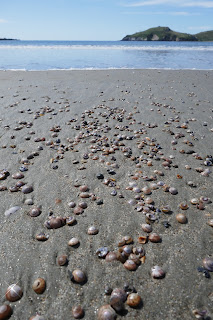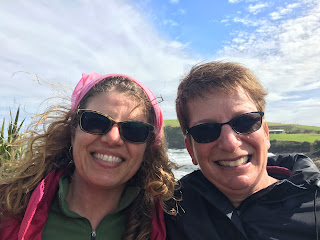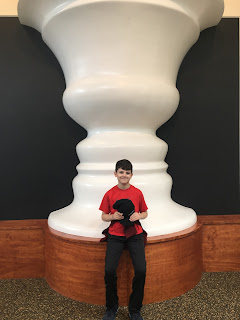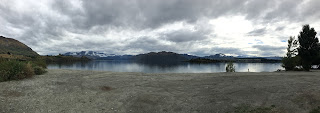 |
| The drive up to The Remarkables was pretty harrowing, with little to no shoulder and VERY long drops. |
We stayed in a tiny cabin at a "Top 10 Holiday Park" with shared kitchen and bath facilities. This was an interesting experience in and of itself, including my chagrin to be microwaving my leftover beef stew in plastic bowls while the Frenchmen beside me sautéed challots in white wine. Our previous Top 10 in Wanaka also had co-ed toilets and showers- surprisingly not awkward after the astonishment of opening the door to a strange man in a towel quickly wore off.
The "Top 10" parks have something for everyone: from suites with their own kitchen, to spots to simply park your van. A popular company for rentals is Jucy, with lime green paint jobs and offensive marketing.
Due to Fran's dissected carotid artery last year, we decided as a family that her dream of bungee-jumping in Queenstown would have to wait until Jeremy grew up.
If she just waits another couple decades, she can do it for free: it's an unpublicized but true fact for the over 75-set! The folks at the Karawau Bridge jump told us that they also used to let you do it free if you were naked but, well, you can imagine what happened.
Instead, we got our thrills from ziplining and jet boat rides. The former started with a gondola ride and involved six lines and lots of conservation and sustainability messages along the way.
Our courage increased with each successive line and even I flipped upside-down by the final, 300m ride.
The Skippers Canyon jet boat ride was even more of a heart-stopper, bringing us within centimeters of the rock canyon walls at alarming speeds. We found out afterwards that our driver had made over 20,000 trips on this river; he was 5th generation living in that canyon and began to drive a motor boat at the age of 12.
The final day we took an only slightly less exciting ride on the Dart River Jet.
We saw several Lord of the Rings filming sites, including the valley where Isengard was CGIed in.
In the middle of all this, we visited the Kiwi Birdlife Park with the "100% guaranteed best kiwi viewing in New Zealand" (and the world, I'm sure). These football sized birds have only vestigial wings and play the ecological role mammals do elsewhere, rooting around the forest floor for insects with their long beaks. The ones we saw were used for breeding and reintroduction programs and could not be photographed. The park also had kea, known for destroying cars and other mischief. Unlike in the US, we could actually interact with this intelligent bird without direct supervision- even though they are powerful enough to bite off a finger!
Now Jeremy gets his much-requested rest of a week in Dunedin while we wait for my mother (and friends David and Gregg from Denver) to arrive in time for Passover.




















































